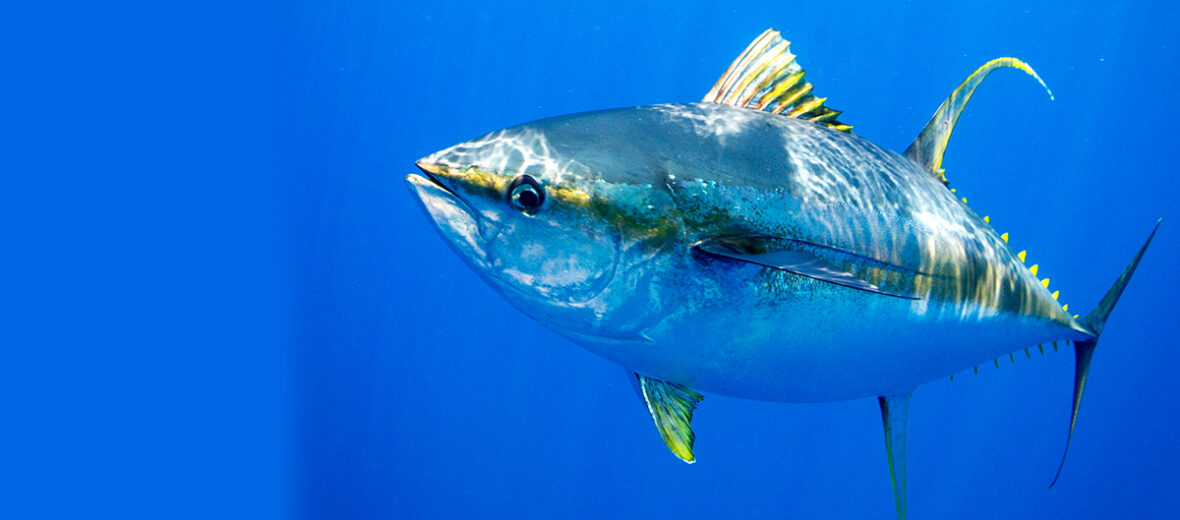
The yellowfin tuna, aka ahi (although that is more related to the bigeye tuna) or albacore (which is a misnaming as albacore are a separate species altogether) are epipelagic (part of the oceanic zone into which enough light penetrates it causing photosynthesis). They are found throughout the world’s tropical and subtropical oceans. Even though they face the threat of overfishing, these fish are still listed as Least Concern by the IUCN as of 2021. Their numbers are decreasing though.
First the Stats…
Scientific name: Thunnus albacares
Weight: Up to 440+ lbs.
Length: Up to 7.10 feet
Lifespan: Up to 7 years
Now on to the Facts!
1.) Yellowfins rank in among the largest of the tuna species, with the bluefin tuna being #1.
2.) They get their name due to the fact that their second dorsal fin and the anal fin, as well as the finlets between said fins & the tail, are bright yellow.
3.) The second pair of dorsal and anal fins can sometimes reach as far back as the tail.
4.) Their pectoral fins are actually longer than those of the bluefin tuna.
5.) These fish can dive to depths of up to 1,000+ feet.
But wait, there’s more on the yellowfin tuna!
6.) Even though they spend most of their time in deeper waters, they can travel far inshore of the continental shelf when water clarity and temperature are desirable and food is readily available.
7.) They can travel in large schools of similarly sized tuna species, like skipjacks. These tuna have also been seen swimming with pods of dolphins.
Did you know…?
Yellowfin tuna can swim at speeds of up to 50 mph!
8.) Their diet consists of smaller fish, like mackerel, pelagic crustaceans, and squid.
9.) Younger yellowfins are preyed on by larger tuna, seabirds, predatory fishes like wahoo, sharks, and billfish.
10.) Adults are preyed on by false killer whales, pelagic sharks like the mako and great white, as well as large marlins.
But wait, there’s still more on the yellowfin tuna!
11.) A common tactic in evading predators is to swim to depths of up to and over 1,000 feet.
12.) The industrial fishing industry is, however, their biggest predator, by far.
Did you know…?
Unlike most other fish, tuna are warm-blooded.
13.) A large number of purse seine sets are now targeting “free schools” that are not associated with dolphins, as well as schooling fish that associate with floating objects.
14.) Back in 2010, an estimated 558,761 metric tons of yellowfin were caught in the central and western Pacific Ocean.
15.) Purse seining predominantly took over commercial tuna fisheries back in the 1960s and 1970s, and remains largely in use to this day.
But wait, there’s still a little more on the yellowfin tuna!
16.) The removal of massive amounts of juvenile yellowfin and bigeye tuna that have yet to reach breeding age has caused major consequences for tuna stocks the world over.
17.) Tuna longlining seeks to target larger sashimi-grade fish that weigh in at around 55 lbs.+ and that are found swimming deeper in the water column.
18.) Bycatch is a serious environmental issue in the longline fishing industry, primarily affecting billfish, pelagic sharks, sea turtles, and even seabirds.
19.) Recreational fishing for Yellowfin Tuna in the Gulf of Mexico brings in upwards of $7 billion annually.
20.) Yellowfin tuna is also extensively used in raw fish dishes, especially sashimi. It is also served seared rare.
But wait, there’s still a tad more on the yellowfin tuna!
21.) The yellowfin is fast becoming a popular replacement for the terribly depleted supplies of southern bluefin tuna.
22.) These fish reproduce via broadcast spawning. This is where females release millions of eggs into the water and the males then fertilize said eggs. There is no parental care.
23.) Yellowfin tuna are capable of reproducing when they reach the age of 2 – 3 years old.
Now a Short Yellowfin Tuna Video!
Be sure to share & comment below! Also, check out the Critter Science YouTube channel. Videos added regularly!
Want to suggest a critter for me to write about? Let me know here.
Some source material acquired from: Wikipedia & IUCN
Photo credit: Ellen Cuylaerts



